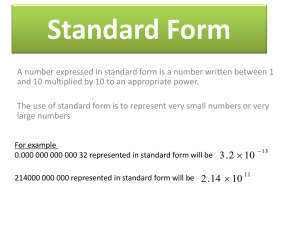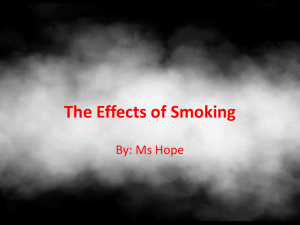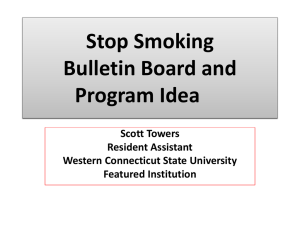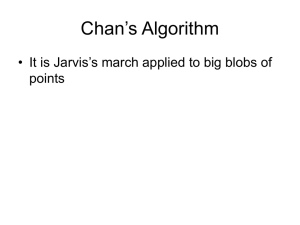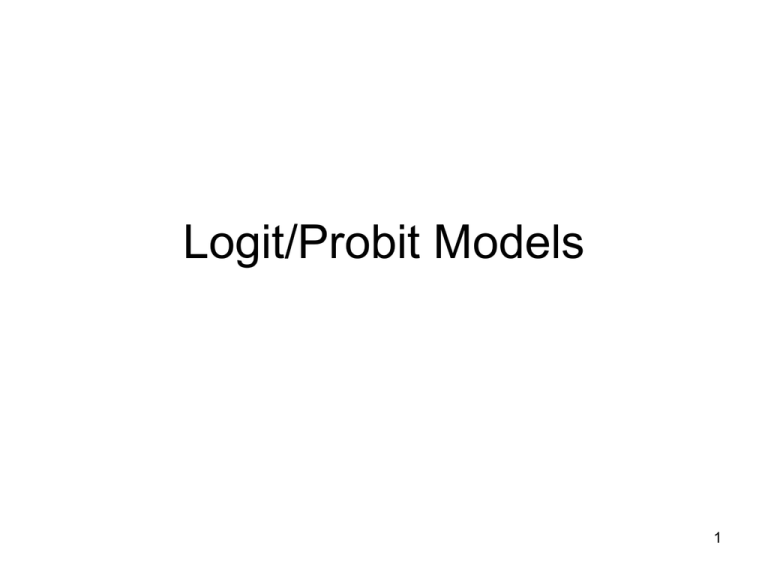
Logit/Probit Models
1
Making sense of the decision rule
• Suppose we have a kid with great scores,
great grades, etc.
• For this kid, xi β is large.
• What will prevent admission? Only a large
negative εi
• What is the probability of observing a large
negative εi ? Very small.
• Most likely admitted. We estimate a large
probability
2
D is trib u tio n o f E p s ilo n
-x β
0 .5 0
xβ
0 .4 0
0 .3 0
0 .2 0
0 .1 0
Values of ε that would allow admission
0 .0 0
-3
-2
-1
0
Values of ε
That will prevent admission
1
2
3
3
Another example
• Suppose we have a kid with bad scores.
• For this kid, xi β is small (even negative).
• What will allow admission? Only a large
positive εi
• What is the probability of observing a large
positive εi ? Very small.
• Most likely, not admitted, so, we estimate
a small probability
4
D is trib u tio n o f E p s ilo n
xβ
0 .5 0
-x β
0 .4 0
Values of ε
that would
allow
admission
0 .3 0
0 .2 0
Values of
ε that would
prevent
admission
0 .1 0
0 .0 0
-3
-2
-1
0
1
2
3
5
Normal (probit) Model
• ε is distributed as a standard normal
– Mean zero
– Variance 1
• Evaluate probability (y=1)
– Pr(yi=1) = Pr(εi > - xi β) = 1 – Ф(-xi β)
– Given symmetry: 1 – Ф(-xi β) = Ф(xi β)
• Evaluate probability (y=0)
– Pr(yi=0) = Pr(εi ≤ - xi β) = Ф(-xi β)
– Given symmetry: Ф(-xi β) = 1 - Ф(xi β)
6
• Summary
– Pr(yi=1) = Ф(xi β)
– Pr(yi=0) = 1 -Ф(xi β)
• Notice that Ф(a) is increasing a.
Therefore, if the x’s increases the
probability of observing y, we would
expect the coefficient on that variable to
be (+)
7
• The standard normal assumption
(variance=1) is not critical
• In practice, the variance may be not equal
to 1, but given the math of the problem, we
cannot separately identify the variance.
8
Logit
• PDF: f(x) = exp(x)/[1+exp(x)]2
• CDF: F(a) = exp(a)/[1+exp(a)]
– Symmetric, unimodal distribution
– Looks a lot like the normal
– Incredibly easy to evaluate the CDF and PDF
– Mean of zero, variance > 1 (more variance
than normal)
9
• Evaluate probability (y=1)
– Pr(yi=1) = Pr(εi > - xi β) = 1 – F(-xi β)
– Given symmetry: 1 – F(-xi β) = F(xi β)
F(xi β) = exp(xi β)/(1+exp(xi β))
10
• Evaluate probability (y=0)
– Pr(yi=0) = Pr(εi ≤ - xi β) = F(-xi β)
– Given symmetry: F(-xi β) = 1 - F(xi β)
– 1 - F(xi β) = 1 /(1+exp(xi β))
• In summary, when εi is a logistic
distribution
– Pr(yi =1) = exp(xi β)/(1+exp(xi β))
– Pr(yi=0) = 1/(1+exp(xi β))
11
STATA Resources
Discrete Outcomes
• “Regression Models for Categorical
Dependent Variables Using STATA”
– J. Scott Long and Jeremy Freese
• Available for sale from STATA website for
$52 (www.stata.com)
• Post-estimation subroutines that translate
results
– Do not need to buy the book to use the
subroutines
12
• In STATA command line type
• net search spost
• Will give you a list of available programs to
download
• One is
Spostado from http://www.indiana.edu/~jslsoc/stata
• Click on the link and install the files
13
Example: Workplace smoking
bans
• Smoking supplements to 1991 and 1993
National Health Interview Survey
• Asked all respondents whether they
currently smoke
• Asked workers about workplace tobacco
policies
• Sample: indoor workers
• Key variables: current smoking and
whether they faced a workplace ban
14
• Data: workplace1.dta
• Sample program: workplace1.doc
• Results: workplace1.log
15
Description of variables in data
•
. desc;
•
•
•
•
•
•
•
•
•
•
•
•
•
•
•
storage display
value
variable name
type
format
label
variable label
-----------------------------------------------------------------------> smoker
byte
%9.0g
is current smoking
worka
byte
%9.0g
has workplace smoking bans
age
byte
%9.0g
age in years
male
byte
%9.0g
male
black
byte
%9.0g
black
hispanic
byte
%9.0g
hispanic
incomel
float %9.0g
log income
hsgrad
byte
%9.0g
is hs graduate
somecol
byte
%9.0g
has some college
college
float %9.0g
-----------------------------------------------------------------------
16
Summary statistics
•
sum;
•
•
•
•
•
•
•
•
•
•
•
•
•
Variable |
Obs
Mean
Std. Dev.
Min
Max
-------------+-------------------------------------------------------smoker |
16258
.25163
.433963
0
1
worka |
16258
.6851396
.4644745
0
1
age |
16258
38.54742
11.96189
18
87
male |
16258
.3947595
.488814
0
1
black |
16258
.1119449
.3153083
0
1
-------------+-------------------------------------------------------hispanic |
16258
.0607086
.2388023
0
1
incomel |
16258
10.42097
.7624525
6.214608
11.22524
hsgrad |
16258
.3355271
.4721889
0
1
somecol |
16258
.2685447
.4432161
0
1
college |
16258
.3293763
.4700012
0
1
17
Heteroskedastic consistent
Standard errors
.
.
.
>
* run a linear probability model for comparison purposes;
* estimate white standard errors to control for heteroskedasticity;
reg smoker age incomel male black hispanic
hsgrad somecol college worka, robust;
Regression with robust standard errors
Very low R2, typical in LP models
Number of obs
F(
9, 16248)
Prob > F
R-squared
Root MSE
=
=
=
=
=
16258
99.26
0.0000
0.0488
.42336
-----------------------------------------------------------------------------|
Robust
smoker |
Coef.
Std. Err.
t
P>|t|
[95% Conf. Interval]
-------------+---------------------------------------------------------------age |
-.0004776
.0002806
-1.70
0.089
-.0010276
.0000725
incomel |
-.0287361
.0047823
-6.01
0.000
-.03811
-.0193621
male |
.0168615
.0069542
2.42
0.015
.0032305
.0304926
black |
-.0356723
.0110203
-3.24
0.001
-.0572732
-.0140714
hispanic |
-.070582
.0136691
-5.16
0.000
-.097375
-.043789
hsgrad |
-.0661429
.0162279
-4.08
0.000
-.0979514
-.0343345
somecol |
-.1312175
.0164726
-7.97
0.000
-.1635056
-.0989293
college |
-.2406109
.0162568
-14.80
0.000
-.272476
-.2087459
worka |
-.066076
.0074879
-8.82
0.000
-.080753
-.051399
_cons |
.7530714
.0494255
15.24
0.000
.6561919
.8499509
------------------------------------------------------------------------------
Since OLS
Report t-stats
18
Same syntax as REG but with probit
. * run probit model;
. probit smoker age incomel male black hispanic
> hsgrad somecol college worka;
Iteration
Iteration
Iteration
Iteration
0:
1:
2:
3:
log
log
log
log
Probit estimates
l ik e l i h o o d
likelihood
likelihood
likelihood
=
-9171.443
=
-8764.068
= -8761.7211
= -8761.7208
Test that all non-constant
Terms are 0
Log likelihood = -8761.7208
Converges rapidly for most
problems
Number of obs
LR chi2(9)
Prob > chi2
Pseudo R2
=
=
=
=
16258
819.44
0.0000
0.0447
- - - - - - - - - - - - - - - - - - - - - - - - - - - - - - - - -- - - - - - - - - - - - - - - - - - - - - - - - - - - - - - - - - - - - - - - - - - - - smoker |
Coef.
Std. Err.
z
P>|z|
[95% Conf. Interval]
-------------+---------------------------------------------------------------age |
-.0012684
.0009316
-1.36
0.173
-.0030943
.0005574
incomel |
-.092812
.0151496
-6.13
0.000
-.1225047
-.0631193
male |
.0533213
.0229297
2.33
0.020
.0083799
.0982627
black |
-.1060518
.034918
-3.04
0.002
-.17449
-.0376137
hispanic |
-.2281468
.0475128
-4.80
0.000
-.3212701
-.1350235
hsgrad |
-.1748765
.0436392
-4.01
0.000
-.2604078
-.0893453
somecol |
-.363869
.0451757
-8.05
0.000
-.4524118
-.2753262
college |
-.7689528
.0466418
-16.49
0.000
-.860369
-.6775366
worka |
-.2093287
.0231425
-9.05
0.000
-.2546873
-.1639702
_cons |
.870543
.154056
5.65
0.000
.5685989
1.172487
- - - - - - - - - - - - - - - - -- - - - - - - - - - - - - - - - - - - - - - - - - - - - - - - - - - - - - - - - - - - - - - - - - - - - - - - - - - - - -
Report z-statistics
Instead of t-stats
19
. dprobit smoker age incomel male black hispanic
> hsgrad somecol college worka;
Probit regression, reporting marginal effects
Log likelihood = -8761.7208
Number of obs
LR chi2(9)
Prob > chi2
Pseudo R2
= 16258
= 819.44
= 0.0000
= 0.0447
-----------------------------------------------------------------------------smoker |
dF/dx
Std. Err.
z
P>|z|
x-bar [
95% C.I.
]
---------+-------------------------------------------------------------------age | -.0003951
.0002902
-1.36
0.173
38.5474 -.000964 .000174
incomel | -.0289139
.0047173
-6.13
0.000
10.421
-.03816 -.019668
male*|
.0166757
.0071979
2.33
0.020
.39476
.002568 .030783
black*| -.0320621
.0102295
-3.04
0.002
.111945 -.052111 -.012013
hispanic*| -.0658551
.0125926
-4.80
0.000
.060709 -.090536 -.041174
hsgrad*|
-.053335
.013018
-4.01
0.000
.335527
-.07885 -.02782
somecol*| -.1062358
.0122819
-8.05
0.000
.268545 -.130308 -.082164
college*| -.2149199
.0114584
-16.49
0.000
.329376 -.237378 -.192462
worka*| -.0668959
.0075634
-9.05
0.000
.68514
-.08172 -.052072
---------+-------------------------------------------------------------------obs. P |
.25163
pred. P |
.2409344 (at x-bar)
-----------------------------------------------------------------------------(*) dF/dx is for discrete change of dummy variable from 0 to 1
z and P>|z| correspond to the test of the underlying coefficient being 0
20
Males are 1.7 percentage points more likely to smoke
Those w/ college degree 21.5 % points
Less likely to smoke
. mfx compute;
Marginal effects after probit
y
= Pr(smoker) (predict)
=
.24093439
-----------------------------------------------------------------------------variable |
dy/dx
Std. Err.
z
P>|z|
[
95% C.I.
]
X
---------+-------------------------------------------------------------------age |
-.0003951
.00029
-1.36
0.173
-.000964
.000174
38.5474
incomel |
-.0289139
.00472
-6.13
0.000
-.03816 -.019668
10.421
male*|
.0166757
.0072
2.32
0.021
.002568
.030783
.39476
black*|
-.0320621
.01023
-3.13
0.002
-.052111 -.012013
.111945
hispanic*|
-.0658551
.01259
-5.23
0.000
-.090536 -.041174
.060709
hsgrad*|
-.053335
.01302
-4.10
0.000
-.07885
-.02782
.335527
somecol*|
-.1062358
.01228
-8.65
0.000
-.130308 -.082164
.268545
college*|
-.2149199
.01146
-18.76
0.000
-.237378 -.192462
.329376
worka*|
-.0668959
.00756
-8.84
0.000
-.08172 -.052072
.68514
-----------------------------------------------------------------------------(*) dy/dx is for discrete change of dummy variable from 0 to 1
10 years of age reduces smoking rates by
4 tenths of a percentage point
10 percent increase in income will reduce smoking
21
By .29 percentage points
.
.
.
.
.
.
* get marginal effect/treatment effects for specific person;
* male, age 40, college educ, white, without workplace smoking ban;
* if a variable is not specified, its value is assumed to be;
* the sample mean. in this case, the only variable i am not;
* listing is mean log income;
prchange, x(male=1 age=40 black=0 hispanic=0 hsgrad=0 somecol=0 worka=0);
probit: Changes in Predicted Probabilities for smoker
age
incomel
male
black
hispanic
hsgrad
somecol
college
worka
min->max
-0.0327
-0.1807
0.0198
-0.0390
-0.0817
-0.0634
-0.1257
-0.2685
-0.0753
0->1
-0.0005
-0.0314
0.0198
-0.0390
-0.0817
-0.0634
-0.1257
-0.2685
-0.0753
-+1/2
-0.0005
-0.0348
0.0200
-0.0398
-0.0855
-0.0656
-0.1360
-0.2827
-0.0785
-+sd/2
-0.0057
-0.0266
0.0098
-0.0126
-0.0205
-0.0310
-0.0605
-0.1351
-0.0365
MargEfct
-0.0005
-0.0349
0.0200
-0.0398
-0.0857
-0.0657
-0.1367
-0.2888
-0.0786
22
•
•
•
•
•
Min->Max: change in predicted probability as x changes from its
minimum to its maximum
0->1: change in pred. prob. as x changes from 0 to 1
-+1/2: change in predicted probability as x changes from 1/2
unit below base value to 1/2 unit above
-+sd/2: change in predicted probability as x changes from 1/2
standard dev below base to 1/2 standard dev above
MargEfct: the partial derivative of the predicted
probability/rate with respect to a given independent variable
23
.
* using a wald test, test the null hypothesis that;
. * all the education coefficients are zero;
. test hsgrad somecol college;
( 1)
( 2)
( 3)
hsgrad = 0
somecol = 0
college = 0
chi2(
3) =
Prob > chi2 =
504.78
0.0000
24
.
.
.
.
>
* how to run the same tets with a -2 log like test;
* estimate the unresticted model and save the estimates ;
* in urmodel;
probit smoker age incomel male black hispanic
hsgrad somecol college worka;
Iteration
Iteration
Iteration
Iteration
0:
1:
2:
3:
log
log
log
log
likelihood
likelihood
likelihood
likelihood
=
-9171.443
=
-8764.068
= -8761.7211
= -8761.7208
Delete some results
. estimates store urmodel;
. * estimate the restricted model.
save results in rmodel;
. probit smoker age incomel male black hispanic
> worka;
Iteration 0:
Iteration 1:
Iteration 2:
log likelihood =
-9171.443
log likelihood = -9022.2473
log likelihood = -9022.1031
Delete some results
. lrtest urmodel rmodel;
likelihood-ratio test
(Assumption: rmodel nested in urmodel)
LR chi2(3)
=
Prob > chi2 =
520.7
25 0 . 0 0 0
Comparing Marginal Effects
Variable
age
incomel
male
Black
hispanic
hsgrad
college
worka
LP
-0.00040
-0.0289
0.0167
-0.0321
-0.0658
-0.0533
-0.2149
-0.0669
Probit
-0.00048
-0.0287
0.0168
-0.0357
-0.0706
-0.0661
-0.2406
-0.0661
Logit
-0.00048
-0.0276
0.0172
-0.0342
-0.0602
-0.0514
-0.2121
-0.0658
26
When will results differ?
• Normal and logit PDF/CDF look:
– Similar in the mid point of the distribution
– Different in the tails
• You obtain more observations in the tails
of the distribution when
– Samples sizes are large
– approaches 1 or 0
• These situations will more likely produce
differences in estimates
27
probit
matrix
matrix
matrix
smoker worka age incomel male black hispanic hsgrad somecol college;
betat=e(b);
* get beta from probit (1 x k);
beta=betat';
covp=e(V);
* get v/c matric from probit (k x k);
* get means of x -- call it xbar (k x 1);
* must be the same order as in the probit statement;
matrix accum zz = worka age incomel male black hispanic hsgrad somecol college,
means(xbart);
matrix xbar=xbart';
* transpose beta;
matrix xbeta=beta'*xbar;
* get xbeta (scalar);
matrix pdf=normalden(xbeta[1,1]);
* evaluate std normal pdf at xbarbeta;
matrix k=rowsof(beta);
* get number of covariates;
matrix Ik=I(k[1,1]);
* construct I(k);
matrix G=Ik-xbeta*beta*xbar';
* construct G;
matrix v_c=(pdf*pdf)*G*covp*G';
* get v-c matrix of marginal effects;
matrix me= beta*pdf;
* get marginal effects;
matrix se_me1=cholesky(diag(vecdiag(v_c))); * get square root of main diag;
matrix se_me=vecdiag(se_me1)';
*take diagonal values;
matrix z_score=vecdiag(diag(me)*inv(diag(se_me)))'; * get z score;
matrix results=me,se_me,z_score;
* construct results matrix;
matrix colnames results=marg_eff std_err z_score;
* define column names;
matrix list results;
* list results;
28
results[10,3]
marg_eff
worka -.06521255
age -.00039515
incomel -.02891389
male
.01661127
black -.03303852
hispanic -.07107496
hsgrad -.05447959
somecol -.11335675
college -.23955322
_cons
.2712018
std_err
.00720374
.00029023
.00471728
.00714305
.0108782
.01479806
.01359844
.01408096
.0144803
.04808183
z_score
-9.0525984
-1.3615156
-6.129356
2.3255154
-3.0371321
-4.8029926
-4.0063111
-8.0503576
-16.543383
5.6404217
-----------------------------------------------------------------------------smoker |
dF/dx
Std. Err.
z
P>|z|
x-bar [
95% C.I.
]
---------+-------------------------------------------------------------------age | -.0003951
.0002902
-1.36
0.173
38.5474 -.000964 .000174
incomel | -.0289139
.0047173
-6.13
0.000
10.421
-.03816 -.019668
male*|
.0166757
.0071979
2.33
0.020
.39476
.002568 .030783
black*| -.0320621
.0102295
-3.04
0.002
.111945 -.052111 -.012013
hispanic*| -.0658551
.0125926
-4.80
0.000
.060709 -.090536 -.041174
hsgrad*|
-.053335
.013018
-4.01
0.000
.335527
-.07885 -.02782
somecol*| -.1062358
.0122819
-8.05
0.000
.268545 -.130308 -.082164
college*| -.2149199
.0114584
-16.49
0.000
.329376 -.237378 -.192462
worka*| -.0668959
.0075634
-9.05
0.000
.68514
-.08172 -.052072
---------+-------------------------------------------------------------------29
* this is an example of a marginal effect for a dichotomous outcome;
* in this case, set the 1st variable worka as 1 or 0;
matrix x1=xbar;
matrix x1[1,1]=1;
matrix x0=xbar;
matrix x0[1,1]=0;
matrix xbeta1=beta'*x1;
matrix xbeta0=beta'*x0;
matrix prob1=normal(xbeta1[1,1]);
matrix prob0=normal(xbeta0[1,1]);
matrix me_1=prob1-prob0;
matrix pdf1=normalden(xbeta1[1,1]);
matrix pdf0=normalden(xbeta0[1,1]);
matrix G1=pdf1*x1 - pdf0*x0;
matrix v_c1=G1'*covp*G1;
matrix se_me_1=sqrt(v_c1[1,1]);
* marginal effect of workplace bans;
matrix list me_1;
* standard error of workplace a;
matrix list se_me_1;
30
symmetric me_1[1,1]
c1
r1 -.06689591
. * standard error of workplace a;
. matrix list se_me_1;
symmetric se_me_1[1,1]
c1
r1 .00756336
-----------------------------------------------------------------------------smoker |
dF/dx
Std. Err.
z
P>|z|
x-bar [
95% C.I.
]
---------+-------------------------------------------------------------------age | -.0003951
.0002902
-1.36
0.173
38.5474 -.000964 .000174
incomel | -.0289139
.0047173
-6.13
0.000
10.421
-.03816 -.019668
male*|
.0166757
.0071979
2.33
0.020
.39476
.002568 .030783
black*| -.0320621
.0102295
-3.04
0.002
.111945 -.052111 -.012013
hispanic*| -.0658551
.0125926
-4.80
0.000
.060709 -.090536 -.041174
hsgrad*|
-.053335
.013018
-4.01
0.000
.335527
-.07885 -.02782
somecol*| -.1062358
.0122819
-8.05
0.000
.268545 -.130308 -.082164
college*| -.2149199
.0114584
-16.49
0.000
.329376 -.237378 -.192462
worka*| -.0668959
.0075634
-9.05
0.000
.68514
-.08172 -.052072
---------+-------------------------------------------------------------------31
L o g it a n d S ta n d a rd N o rm a l C D F
0 .4 5
0 .4 0
S ta n d a rd N o rm a l
0 .3 5
0 .3 0
Y
0 .2 5
0 .2 0
L o g it
0 .1 5
0 .1 0
0 .0 5
0 .0 0
-7
-5
-3
-1
1
3
5
7
X
32
Pseudo R2
• LLk log likelihood with all variables
• LL1 log likelihood with only a constant
• 0 > LLk > LL1 so | LLk | < |LL1|
• Pseudo R2 = 1 - |LL1/LLk|
• Bounded between 0-1
• Not anything like an R2 from a regression
33
Predicting Y
• Let b be the estimated value of β
• For any candidate vector of xi , we can predict
probabilities, Pi
• Pi = Ф(xib)
• Once you have Pi, pick a threshold value, T, so
that you predict
• Yp = 1 if Pi > T
• Yp = 0 if Pi ≤ T
• Then compare, fraction correctly predicted
34
• Question: what value to pick for T?
• Can pick .5 – what some textbooks
suggest
– Intuitive. More likely to engage in the activity
than to not engage in it
– When is small (large), this criteria does a
poor job of predicting Yi=1 (Yi=0)
35
• *predict probability of smoking;
• predict pred_prob_smoke;
• * get detailed descriptive data about predicted
prob;
• sum pred_prob, detail;
• * predict binary outcome with 50% cutoff;
• gen pred_smoke1=pred_prob_smoke>=.5;
• label variable pred_smoke1 "predicted smoking, 50%
cutoff";
• * compare actual values;
• tab smoker pred_smoke1, row col cell;
36
Predicted values close
To sample mean of y
Mean of predicted
Y is always close to actual mean
(0.25163 in this case)
. predict pred_prob_smoke;
(option p assumed; Pr(smoker))
. * get detailed descriptive data about predicted prob;
. sum pred_prob, detail;
Pr(smoker)
------------------------------------------------------------Percentiles
Smallest
1%
.0959301
.0615221
5%
.1155022
.0622963
10%
.1237434
.0633929
Obs
16258
25%
.1620851
.0733495
Sum of Wgt.
16258
50%
75%
90%
95%
99%
.2569962
.3187975
.3795704
.4039573
.4672697
Largest
.5619798
.5655878
.5684112
.6203823
Mean
Std. Dev.
.2516653
.0960007
Variance
Skewness
Kurtosis
.0092161
.1520254
2.149247
No one predicted to have a
High probability of smoking
Because mean of Y closer to 0
37
Some nice properties of the Logit
• Outcome, y=1 or 0
• Treatment, x=1 or 0
• Other covariates, x
• Context,
– x = whether a baby is born with a low weight
birth
– x = whether the mom smoked or not during
pregnancy
38
• Risk ratio
RR = Prob(y=1|x=1)/Prob(y=1|x=0)
Differences in the probability of an event
when x is and is not observed
How much does smoking elevate the chance
your child will be a low weight birth
39
• Let Yyx be the probability y=1 or 0 given
x=1 or 0
• Think of the risk ratio the following way
• Y11 is the probability Y=1 when X=1
• Y10 is the probability Y=1 when X=0
• Y11 = RR*Y10
40
• Odds Ratio
OR=A/B = [Y11/Y01]/[Y10/Y00]
A = [Pr(Y=1|X=1)/Pr(Y=0|X=1)]
= odds of Y occurring if you are a smoker
B = [Pr(Y=1|X=0)/Pr(Y=0|X=0)]
= odds of Y happening if you are not a smoker
What are the relative odds of Y happening if you do or
do not experience X
41
• Suppose Pr(Yi =1) = F(βo+ β1Xi + β2Z) and
F is the logistic function
• Can show that
• OR = exp(β1) = e β1
• This number is typically reported by most
statistical packages
42
• Details
•
•
•
•
•
•
•
Y11 = exp(βo+ β1 + β2Z) /(1+ exp(βo+ β1+ β2Z) )
Y10 = exp(βo+ β2Z)/(1+ exp(βo+β2Z))
Y01 = 1 /(1+ exp(βo+ β1 + β2Z) )
Y00 = 1/(1+ exp(βo+β2Z)
[Y11/Y01] = exp(βo+ β1 + β2Z)
[Y10/Y00] = exp(βo+ β2Z)
OR=A/B = [Y11/Y01]/[Y10/Y00]
= exp(βo+ β1 + β2Z)/ exp(βo + β2Z)
= exp(β1)
43
• Suppose Y is rare, mean is close to 0
– Pr(Y=0|X=1) and Pr(Y=0|X=0) are both close
to 1, so they cancel
• Therefore, when mean is close to 0
– Odds Ratio ≈ Risk Ratio
• Why is this nice?
44
Population Attributable Risk
•
•
•
•
•
PAR
Fraction of outcome Y attributed to X
Let xs be the fraction use of x
PAR = (RR – 1)xs /[(1-xs) + RRxs]
Derived on next 2 slides
45
Population attributable risk
• Average outcome in the population
• yc = (1-xs) Y10 + xs Y11 = (1- xs)Y10 + xs (RR)Y10
• Average outcomes are a weighted average of
outcomes for X=0 and X=1
• What would the average outcome be in the
absence of X (e.g., reduce smoking rates to 0)?
• Ya = Y10
46
• Therefore
– yc = current outcome
– Ya = Y10 outcome with zero smoking
– PAR = (yc – Ya)/yc
– Substitute definition of Ya and yc
– Reduces to (RR – 1)xs /[(1-xs) + RRxs]
47
Example: Maternal Smoking and
Low Weight Births
• 6% births are low weight
– < 2500 grams
– Average birth is 3300 grams (5.5 lbs)
• Maternal smoking during pregnancy has
been identified as a key cofactor
– 13% of mothers smoke
– This number was falling about 1 percentage
point per year during 1980s/90s
– Doubles chance of low weight birth
48
Natality detail data
• Census of all births (4 million/year)
• Annual files starting in the 60s
• Information about
– Baby (birth weight, length, date, sex, plurality, birth
injuries)
– Demographics (age, race, marital, educ of mom)
– Birth (who delivered, method of delivery)
– Health of mom (smoke/drank during preg, weight
gain)
49
•
•
•
•
•
Smoking not available from CA or NY
~3 million usable observations
I pulled .5% random sample from 1995
About 12,500 obs
Variables: birthweight (grams), smoked,
married, 4-level race, 5 level education,
mothers age at birth
50
• Notice a few things
– 13.7% of women smoke
– 6% have low weight birth
Raw
• Pr(LBW | Smoke) =10.28%
Numbers
• Pr(LBW |~ Smoke) = 5.36%
• RR
= Pr(LBW | Smoke)/ Pr(LBW |~ Smoke)
= 0.1028/0.0536 = 1.92
51
Asking for odds ratios
• Logistic y x1 x2;
• In this case
• xi: logistic lowbw smoked age
married i.educ5 i.race4;
52
PAR
• PAR = (RR – 1) xs /[(1- xs) + RR xs]
• xs= 0.137
• RR = 1.96
• PAR = 0.116
• 11.6% of low weight births attributed to
maternal smoking
53
D *
P r(Y 1)
0 D * 1
1
1
1
22.222
0.045
0
1
5.3 / 22.222 0.239
Endowment effect
• Ask group to fill out a survey
• As a thank you, give them a coffee mug
– Have the mug when they fill out the survey
• After the survey, offer them a trade of a
candy bar for a mug
• Reverse the experiment – offer candy bar,
then trade for a mug
• Comparison sample – give them a choice
of mug/candy after survey is complete
Contrary to simply consumer
choice model
• Standard util. theory model assume MRS
between two good is symmetric
• Lack of trading suggests an “endowment”
effect
– People value the good more once they own it
– Generates large discrepancies between WTP
and WTA
Policy implications
• Example:
– A) How much are you willing to pay for clean
air?
– B) How much do we have to pay you to allow
someone to pollute
– Answer to B) orders of magnitude larger than
A)
– Prior – estimate WTP via A and assume
equals WTA
• Thought of as loss aversion –
Problem
• Artificial situations
• Inexperienced may not know value of the
item
• Solution: see how experienced actors
behave when they are endowed with
something they can easily value
• Two experiments: baseball card shows
and collectible pins
Baseball cards
• Two pieces of memorabilia
– Game stub from game Cal Ripken Jr set the
record for consecutive games played (vs. KC,
June 14, 1996)
– Certificate commemorating Nolan Ryans’
300th win
• Ask people to fill out a 5 min survey. In
return, they receive one of the pieces, then
ask for a trade

